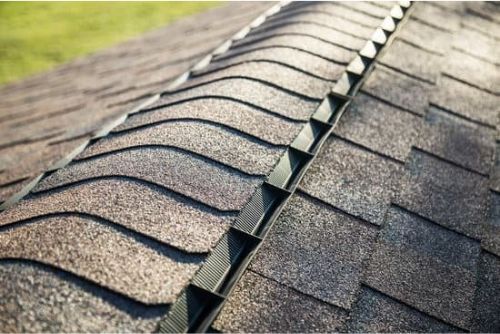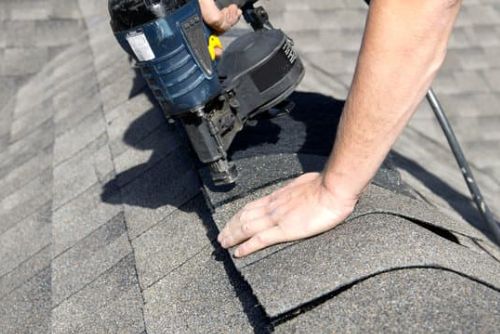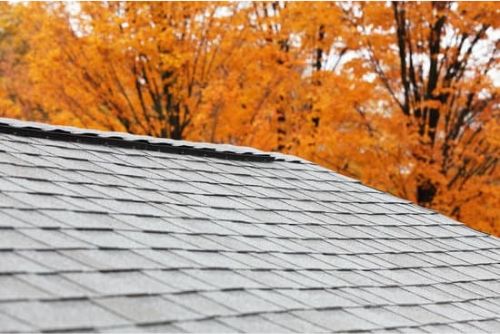Have you ever wondered what a ridge vent on a house roof was? You're not alone. Many homeowners don't understand these vents or why they're installed. I'll explain ridge vents and their benefits in this article.
Ridge vents aren't just for looks. They're pretty and add character to your home's exterior, but they're also functional. Ridge vents release hot attic air through roofline openings. This keeps your attic cool in the summer.
Finally, ridge vents give homes without exhaust systems much-needed ventilation. Mold growth from moisture buildup in attics damages insulation and lowers indoor air quality, so we need enough airflow. If you've noticed one or more ridges running down your roof line, now you know they're important for home safety and health. Learn more about what is a ridge vent in this informative article.
You've probably wondered about your roof's ridge vent. A ridge vent is a roof peak air exhaust vent that ventilates the attic. Warm air from inside the home escapes through the roof, leaving cooler air behind. This regulates the house temperature year-round.
Home and building ventilation systems often include ridge vents. They circulate fresh air around your attic, preventing moisture buildup and lowering energy costs due to better insulation. Ridge vents can be metal or plastic, depending on their purpose and location, making them easy to install and maintain.
After learning what a ridge vent is, let's see how installing one on our roofs can benefit us.
Roof ridge ventilation has many advantages. It can improve home air quality, lower energy costs, and prolong roofing materials. Aluminum ridge vents offer four main benefits:
By taking advantage of these four major benefits of a good ventilation attic system, homeowners can rest assured that their homes will remain safe and comfortable year-round without breaking the bank.

Roofs need ridge vents. They regulate airflow and prevent moisture buildup, which can cause home rot and mold. Shingle and type ridge vents are the main types. Shingle vents seal roof peaks with asphalt shingles and metal flashing. Type ridge vents are pre-formed plastic strips installed directly onto your roof decking.
Both ridge vents have pros and cons. Due to temperature changes, shingle vents need to be inspected more often than ridge vents, but they look better. Type ridge vents are cheaper upfront because they require less labour to install, but they may not provide as much weather protection as shingle vents.
Both types of attic ventilation will keep your home comfortable year-round and protect its structural integrity from water infiltration and condensation buildup.
Maintaining your roof requires ridge vent installation. It's simple but requires preparation and caution. First, determine your roof ridge's vent size. Hire a professional to measure and install the right size.
Next, secure all the shingles around the vent installation area. Installation will not damage or displace existing shingles. Use sealants to ensure a watertight fit.
Finally, carefully nail or screw the ridge vent to the roof. Before connecting the wiring or air vents for the new roof vent, check for separation between the vent and adjacent shingles. These steps prepare your roof for improved ventilation.
After proper installation, we can discuss the pros and cons of ridge vents.

Ridge vents provide cost-effective attic ventilation. They offer several advantages, including:
Ridge vents have many advantages, but they also have drawbacks. These include debris buildup, extreme temperatures, noise issues in high winds, and a limited coverage area compared to other ventilation systems. Before installing any ventilation system, consult a professional to ensure proper installation for the best results. You will have more ideas on what is a ridge vent by looking through its advantages and disadvantages.
Before using a ridge vent, consider your climate.
Ridge vents improve attic ventilation and reduce hot air buildup. The climate affects their efficacy. Ridge vents increase airflow in hotter climates because hot air rises faster than cold air. This lowers summer energy bills and keeps homes cooler. However, colder climates require more vent insulation and fan power to maximise efficiency.
Monitor your ridge vent regularly to ensure it works well regardless of weather or temperature. If your house has higher temperatures in the winter or when there is no wind, you may need to adjust to improve efficiency. Checking for dust accumulation near rooflines can also affect vent system performance.
The right maintenance schedule will keep your ridge vents working throughout the year. Thus, local climate conditions must be considered when maintaining these devices to maximise efficiency over time. To optimize attic ventilation, one must understand ridge vent maintenance.

Maintaining a ridge vent is difficult but necessary for attic health and safety. It's important to check shingles up to the ridge for damage or improper placement to ensure airflow. Check the vent base frequently for gaps that could let moisture or pests in. If each vent's weather stripping wears out, it may need to be replaced.
Ridge vents need proper ventilation and inspection to work properly. This means leaving enough space between intake vents near the eaves and outlet vents like ridge vents. Airflow will be inefficient if these two types of vents aren't spaced properly, which can cause attic condensation and structural damage.
To optimize performance, clean intake and exhaust vents at least once a year (or more often, depending on environmental conditions). Clogged vents make it hard for hot air to escape the attic, which could affect home temperature control. Taking a few minutes occasionally keeps things running smoothly. Installing a roof ridge ventilation system requires materials and labor, which can add up.
After discussing ridge vent maintenance, let's discuss cost. Carefully install a roof ridge ventilation system. Materials depend on roof size and vent type. The difficulty of accessing the ridge vent installation site will also affect labor costs.
Budget for installation supplies and tools. Installing a ridge vent without proper ventilation may require additional insulation. This will cost a lot but is necessary for long-term energy efficiency and home comfort. When installing a new ridge vent, use high-quality sealant products to avoid gaps or water leaks around the edges, which could damage the structure over time.
Quality roof ridge ventilation increases energy efficiency and saves money on repairs. Airflow between attic spaces and outside air makes temperature regulation easier in all seasons, potentially lowering monthly utility bills. When choosing a roof ridge ventilator system, it's important to consider product costs, whether you're making improvements now or planning for future renovations.
A roof ridge ventilation system keeps attic air circulating and lowers energy costs. Sealing is crucial for ridge vent installation. Before sealing, clean your roof. To keep moisture out of your home, seal all exposed edges. After cleaning and sealing, apply a high-quality waterproof sealant around your ridge vent to bond the shingles and vent. Water can cause costly damage, so seal all gaps. In extreme weather or heavy storms, use extra caulking or sealing to prevent leaks. By taking these steps now, you can rest assured that your roof will stay dry and secure for years.

A ridge vent, also called an attic exhaust or high-level ventilation system, is a roofing solution that improves airflow. This prevents attic mold, mildew, and other moisture issues. However, using this type of system has its own common issues:
Professional installation and regular checkups are necessary for these solutions to truly improve your home's energy efficiency and comfort. Only then can you be sure your property is safe from costly damages caused by improper use or maintenance of such systems. Transition: Properly testing a roof ridge ventilation system ensures optimal performance.
Roof ridge ventilation systems must be tested to ensure adequate attic airflow. Use an infrared temperature gun. This tool lets you measure the temperature difference between air inside and outside vents at different levels in your attic. If temperatures vary, your vents are working.
Checking for airflow from each roof ridge vent is another way to test your ridge vent. Binoculars or standing directly beneath a vent and looking up should show you if your vents are letting cool air into your attic during hot summer days. When checking airflow through the house's ventilation system, open gable end vents, soffit panels, and louvers.
Always consider safety before testing a roof with a ridge vent. Wear hard hats, gloves, and closed-toe shoes when inspecting or maintaining these systems, and never use power tools or ladders near rooftops alone.

Installing or repairing ridge vents requires safety. Understand and follow safety precautions for the safest experience. First, wear gloves and long sleeves when working near the attic roof to avoid falling debris. Beware of attic wiring problems and exposed wires.
Avoid climbing over power lines when climbing onto the roof to install or maintain soffit vents or other rooftop accessories. Before climbing ladders, secure them and have someone steady them. Finally, when cutting shingles or other materials that release dust, always wear a mask and eye protection.
In conclusion, taking proper safety precautions before installing a ridge vent system can protect you and others from hazardous material injuries. Keeping this in mind will allow us to innovate roof ventilation systems without endangering anyone. We'll discuss ways to improve your roof's ridge ventilation system.
Ridge vents are great for airflow. They vent warm air from the attic and prevent roof moisture buildup. They don't always work well, though. Several steps can improve ridge vent efficiency.
First, make sure all roof vents meet or exceed local building codes. This optimises their performance. Each vent should be sealed against wind and water. Remove any obstructions around the vent to improve airflow. Finally, seal any vent openings with flashing tape or caulk to prevent air leakage.
Check your roof's surrounding structure for cracks or gaps that could affect its performance. Clean gutters and downspouts to avoid poor drainage or vent airflow blockage. These simple steps will optimize your ridge vents and protect your home and wallet from costly ventilation repairs.
There are several ways to improve the efficiency of your roof's ridge vent and solve problems. Understand ridge vents and how they work first. A roof's ridge vent lets air in and out and ventilates the space below. This gap lets warm air escape from the home, reducing moisture.
Next, check your ridge vent installation for problems. Gaps between the shingles and the wall or other signs of improper air circulation may indicate poor installation. Before making any changes, hire a professional contractor to ensure proper installation. Check for snow on the roof blocking the ridge vent, which will prevent airflow throughout your home.
For year-round comfort and safety, your roof's ridge vent must perform well. To do this, regularly check your setup and potential blockages like roof snow. If you're having trouble with a ridge roof installation, contact a professional.

Roofs need ridge vents. It ventilates the attic and prevents it from overheating or freezing. Snow on ridge vents can cause insulation issues and water leaks. How do you know if snow is affecting your ridge vent? Some advice:
If you think snow accumulation is affecting your home's ventilation system, call a professional to inspect and fix it before it gets worse. Keeping an eye out for ice dams, deteriorating shingles, unusual noises, or higher energy bills can help keep everything working even when temperatures drop below freezing.
Finally, ridge vents improve ventilation and energy efficiency. They suit various climates and homes. A professional can help you choose the right house size. Ridge vents require little maintenance, so once installed, they should run smoothly. Finally, properly maintained vents can last 20 years, giving you value for money and peace of mind that your home is safe from extreme weather. Overall, buying a ridge vent may be my best decision. Now you already know what is a ridge vent and how it works.
Roof ventilation requires the right ridge vent. How do you choose the right ridge vent with so many options? Let's compare each type of ridge vent to help you choose and ensure quality.
Continuously vented ridge cap shingles are the most common. This perforated ventilation is installed like asphalt or fiberglass shingles but allows more airflow. These vents improve energy efficiency and reduce cooling costs by 30% by evenly distributing airflow along the ridgeline.
"Air channel" ridge vents are also popular. These systems use small slots instead of holes to circulate air across the roof, making them more efficient than traditional vents. Since they're slotted, they're better at blocking wind-driven rain and snow. Due to the lack of wear and tear, these systems require less maintenance over time.
Installing a proper ridge vent will improve structure ventilation and lower energy costs, regardless of type. With so many options, doing some research beforehand will help you get exactly what you need without compromising quality or performance.
It's hard to determine your roof's ridge vent size. Luckily, there are some tricks to help you get it right. First, learn about ridge vents.
Ridge vents are air-flow systems along roof peaks. It vents hot air and moisture from the attic while blocking the elements. This reduces humidity, cools your home, and prevents mold and mildew growth in winter. They can also balance airflow with soffit vents or gable ends to maximise energy efficiency year-round.
Measure your roofline's width, length, and square footage to find the right ridge vent for your home. After taking these measurements, check the manufacturer's website or packaging for product recommendations. Many companies offer expert advice tailored to customers' needs, so don't hesitate to ask questions.
With accurate measurements, you can buy and install a ridge vent that meets all your needs for years of improved ventilation.
Ridge vents are good for all climates, right? It's true. Ridge vents help cool your roof in summer and warm it in winter. How do you know if a ridge vent suits your climate?
First, your climate matters. Ridge vents allow air to flow freely through the attic, reducing heat buildup in hot or humid climates. If you live in a cold climate, a ridge vent won't provide much winter warmth since most heat escapes through the roof.
Choosing a ridge vent depends on weather and size. Larger homes need more ventilation, so a larger ridge vent may be needed. There are many sizes, so finding one that fits should be easy.
Installing a ridge vent improves airflow and regulates temperature in your home, making it comfortable and energy efficient. Why not include this simple but effective tool in your next remodeling project?
Ridge vents keep your roof cool and comfortable. Is special maintenance needed? Yes. Ridge vents need regular maintenance.
Take extra steps to maximize your ridge vent. To allow airflow, clear the vent area. Check the vent for holes or cracks, which reduce its efficiency. Finally, check the surrounding shingles for wear and tear and replace any that are damaged.
Ridge vents regulate airflow and temperature without taking up much space. Trust us—regular inspection and maintenance are worth it. Without proper maintenance, your ridgeline ventilation system may need costly repairs.
Ridge vents are popular roof vents. For how long? We'll answer that today.
Ridge vents are made of durable plastic or metal. They should last over 20 years, depending on the material quality and climate. When regularly maintained, ridge vents can last even in wetter climates.
UV protection treatments can extend the life of your ridge vent beyond regular maintenance. These extra steps may help you get the most out of your investment. Maintaining your roof now could save you money on repairs later.
Whether you get regular checkups or not, ridge vents can last for years with proper maintenance, so why not?